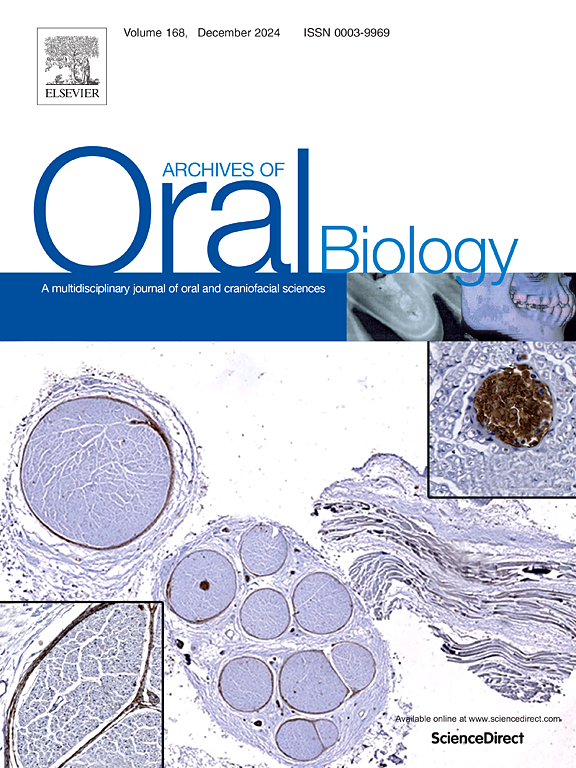Distributions of orofacial two-point discrimination threshold: A cross-sectional study in healthy population and patients with pain-related temporomandibular disorders
IF 2.1
4区 医学
Q2 DENTISTRY, ORAL SURGERY & MEDICINE
引用次数: 0
Abstract
Objective
This study aimed to explore the distribution and difference of orofacial two-point discrimination threshold (2-PDT) between patients with pain-related Temporomandibular Disorders (TMDs) and healthy individuals.
Methods
This study included 58 pain-related TMDs patients and 58 healthy individuals. Demographics including the gender, age of participants were collected. Temporomandibular joint (TMJ), mandible, zygomatic and temporal 2-PDTs were examined for statistical analyses.
Results
Pain-related TMDs patients showed significantly higher 2-PDTs in all tested regions (p < 0.001). In gender subgroups of the control, males had significantly higher 2-PDTs than females in bilateral TMJ and temporal regions. In gender subgroups of patients, no statistical 2-PDT differences were found between males and females. Pain-related TMDs females had higher 2-PDTs than control females in all regions, which were also observed between pain-related TMDs males and control males (p < 0.001), except for temporal 2-PDTs. Only pain-related TMDs were significantly associated with orofacial 2-PDTs with β coefficients varied from 3.5 to 7 (p < 0.001). The discrimination performance of 2-PDTs on pain-related TMDs was considered effective, while the TMJ 2-PDTs was the best single predictor (Area under curve: 0.833).
Conclusion
Pain-related TMDs patients had weaker orofacial tactile acuity, which was consistent in gender subgroups, except for the temporal region of males. Healthy males had weaker tactile acuity compared to females in TMJ and temporal regions. No significant gender effect on orofacial tactile acuity was observed among male and female patients. The 2-PDTs of the tested sites, especially for TMJ, has the potential for further utilization in pain-related TMDs patients.
口面部两点辨别阈值的分布:健康人群和疼痛相关颞下颌疾病患者的横断面研究
目的探讨疼痛相关性颞下颌疾病(TMDs)患者与健康人群口面两点辨别阈值(2-PDT)的分布及差异。方法本研究包括58例疼痛相关TMDs患者和58例健康人。收集了参与者的性别、年龄等人口统计数据。对颞下颌关节(TMJ)、下颌骨、颧骨和颞骨2-PDTs进行统计学分析。结果西班牙相关TMDs患者在所有检测区域的2-PDTs均显著升高(p <; 0.001)。在对照组的性别亚组中,男性在双侧TMJ和颞叶区的2-PDTs明显高于女性。在患者的性别亚组中,男性和女性之间的2-PDT无统计学差异。在所有地区,女性疼痛相关TMDs患者的2-PDTs均高于对照组女性,在男性疼痛相关TMDs患者和对照组男性患者之间也观察到这一点(p <; 0.001),除了颞部的2-PDTs。只有疼痛相关的tmd与口面部2-PDTs显著相关,β系数从3.5到7不等(p <; 0.001)。2-PDTs对疼痛相关颞下颌关节痛的判别效果良好,而TMJ 2-PDTs是最佳的单一预测因子(曲线下面积:0.833)。结论疼痛相关TMDs患者的口面触觉敏锐度较弱,除男性颞区外,各性别亚组均存在差异。健康男性在颞颌关节和颞叶区的触觉敏锐度较女性弱。男性和女性患者的口面部触觉敏锐度无明显性别差异。试验部位的2-PDTs,特别是TMJ,具有进一步应用于疼痛相关TMDs患者的潜力。
本文章由计算机程序翻译,如有差异,请以英文原文为准。
求助全文
约1分钟内获得全文
求助全文
来源期刊

Archives of oral biology
医学-牙科与口腔外科
CiteScore
5.10
自引率
3.30%
发文量
177
审稿时长
26 days
期刊介绍:
Archives of Oral Biology is an international journal which aims to publish papers of the highest scientific quality in the oral and craniofacial sciences. The journal is particularly interested in research which advances knowledge in the mechanisms of craniofacial development and disease, including:
Cell and molecular biology
Molecular genetics
Immunology
Pathogenesis
Cellular microbiology
Embryology
Syndromology
Forensic dentistry
 求助内容:
求助内容: 应助结果提醒方式:
应助结果提醒方式:


